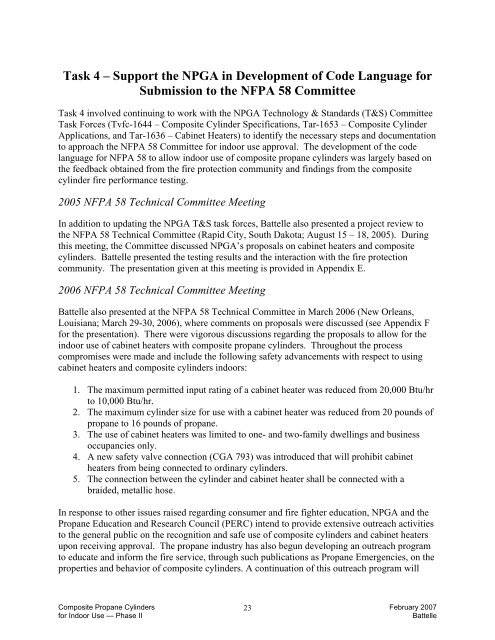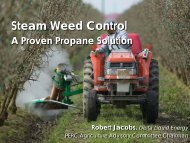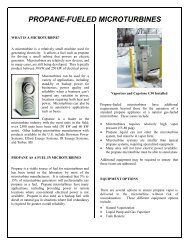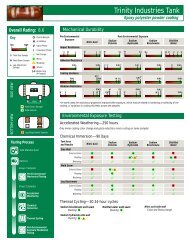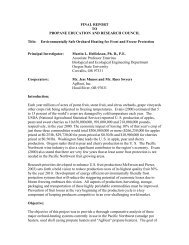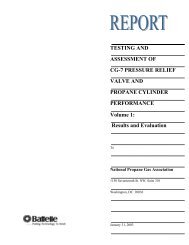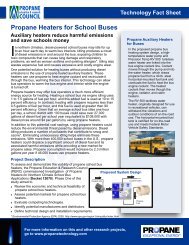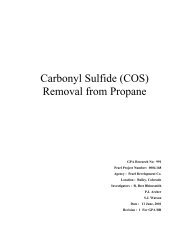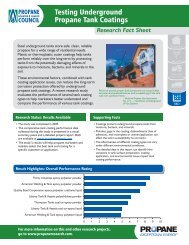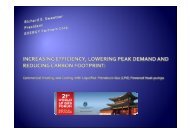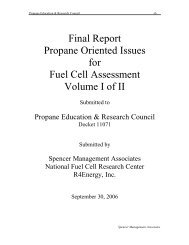Code Approval of Composite Propane Cylinders for Indoor Use ...
Code Approval of Composite Propane Cylinders for Indoor Use ...
Code Approval of Composite Propane Cylinders for Indoor Use ...
Create successful ePaper yourself
Turn your PDF publications into a flip-book with our unique Google optimized e-Paper software.
Task 4 – Support the NPGA in Development <strong>of</strong> <strong>Code</strong> Language <strong>for</strong>Submission to the NFPA 58 CommitteeTask 4 involved continuing to work with the NPGA Technology & Standards (T&S) CommitteeTask Forces (Tvfc-1644 – <strong>Composite</strong> Cylinder Specifications, Tar-1653 – <strong>Composite</strong> CylinderApplications, and Tar-1636 – Cabinet Heaters) to identify the necessary steps and documentationto approach the NFPA 58 Committee <strong>for</strong> indoor use approval. The development <strong>of</strong> the codelanguage <strong>for</strong> NFPA 58 to allow indoor use <strong>of</strong> composite propane cylinders was largely based onthe feedback obtained from the fire protection community and findings from the compositecylinder fire per<strong>for</strong>mance testing.2005 NFPA 58 Technical Committee MeetingIn addition to updating the NPGA T&S task <strong>for</strong>ces, Battelle also presented a project review tothe NFPA 58 Technical Committee (Rapid City, South Dakota; August 15 – 18, 2005). Duringthis meeting, the Committee discussed NPGA’s proposals on cabinet heaters and compositecylinders. Battelle presented the testing results and the interaction with the fire protectioncommunity. The presentation given at this meeting is provided in Appendix E.2006 NFPA 58 Technical Committee MeetingBattelle also presented at the NFPA 58 Technical Committee in March 2006 (New Orleans,Louisiana; March 29-30, 2006), where comments on proposals were discussed (see Appendix F<strong>for</strong> the presentation). There were vigorous discussions regarding the proposals to allow <strong>for</strong> theindoor use <strong>of</strong> cabinet heaters with composite propane cylinders. Throughout the processcompromises were made and include the following safety advancements with respect to usingcabinet heaters and composite cylinders indoors:1. The maximum permitted input rating <strong>of</strong> a cabinet heater was reduced from 20,000 Btu/hrto 10,000 Btu/hr.2. The maximum cylinder size <strong>for</strong> use with a cabinet heater was reduced from 20 pounds <strong>of</strong>propane to 16 pounds <strong>of</strong> propane.3. The use <strong>of</strong> cabinet heaters was limited to one- and two-family dwellings and businessoccupancies only.4. A new safety valve connection (CGA 793) was introduced that will prohibit cabinetheaters from being connected to ordinary cylinders.5. The connection between the cylinder and cabinet heater shall be connected with abraided, metallic hose.In response to other issues raised regarding consumer and fire fighter education, NPGA and the<strong>Propane</strong> Education and Research Council (PERC) intend to provide extensive outreach activitiesto the general public on the recognition and safe use <strong>of</strong> composite cylinders and cabinet heatersupon receiving approval. The propane industry has also begun developing an outreach programto educate and in<strong>for</strong>m the fire service, through such publications as <strong>Propane</strong> Emergencies, on theproperties and behavior <strong>of</strong> composite cylinders. A continuation <strong>of</strong> this outreach program will<strong>Composite</strong> <strong>Propane</strong> <strong>Cylinders</strong> 23February 2007<strong>for</strong> <strong>Indoor</strong> <strong>Use</strong> — Phase IIBattelle


